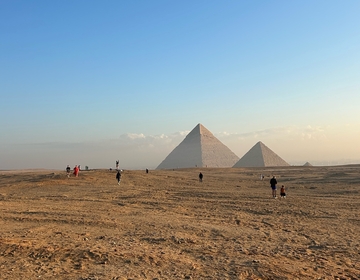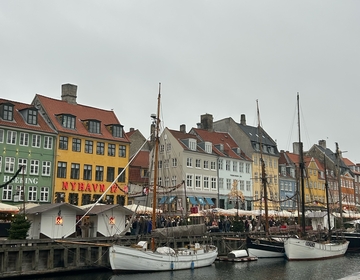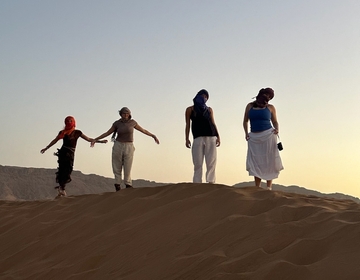Granada: Part I
Granada is a stew of religions. A stone-roaded, twisty-streeted, living history map. Coca-cola signs hang above bars in circles of the signature Grenadine white-and-blue ceramic style. Street names change at every intersection, even while continuing in the same direction. A small archway leads down a tiny street of shops, formerly a silk market. Around the corner is the Aljibe de Trillo, which holds just some of the secrets to the city’s genius water system. Teterías (Arab-influenced tea-rooms) calmly await visitors. Carmens abound with orange trees and special views of, oh yes, the Alhambra.
The Alhambra sits atop the city, guarding and guiding it as it has for centuries through all sorts of transitions. The complex dates to about the 13th or 14th century (though there may have been construction earlier). Now you can visit: Generalife (palace and gardens), Palacio de Carlos V (16th-17th-century Roman-style palace with circular inside and small art museum), Palacios Nazaríes (the most well-known with incredible patios, ceilings, and the quintessential tiles sold in souvenir shops around the country), and the Alcazaba (lookout point with flags and views of the city and surrounding mountains). Quranic ideals flood the Palacios Nazaríes and Generalife in particular with patios of ponds, greenery, and fountains, paradise in the sacred book of Islam, as well as script from text itself.
Once the Catholics took over the Iberian Peninsula, at the end of the 1400s by Ferdinand and Isabella (los reyes católicos), they continued using the Alhambra, described to us as a “city” by a local tour-guide. But they destroyed the Great Mosque, and, upon that exact spot, placed a church. Our tour-guide explained that a key to understanding the city is that the shift to Catholic rule did not entail eradication of all that had come before (though there was destruction). So when he pointed out the Iglesia de San Gil y Santa Ana, he noted that the tower still looks exactly like a minaret, and still has the blue and white patterns from the time of Muslim-rule--it’s mudejar and reflects the coexistence of Muslim and Christian cultures.
Today, the main cathedral of Granada is the second-largest in Spain. We only got a brief look inside, but it seemed like one of the more interesting cathedrals in Spain visually. The inside is a bright white--quite a change from the usual tannish brown stone. The outside, though, does have that tan color, which makes the inside that much more exciting. A mosque was here before, and it was destroyed and replaced with the cathedral. According to Rick Steves, there was a plot of land nearby that would have been more suitable for the building of the cathedral, but the new rulers insisted on using the same plot as the mosque. Also according to Steves, the “Ave Maria” at front-and-center of the cathedral’s facade was accepted by the Muslims because Mary plays a large role in the Quran. This is just one of many tidbits of information that make Granada unique. Though the religion in power shifted, there were still aspects of the previous culture that remained and kept it alive with the city’s inhabitants.
Instead of paying to go further into the cathedral, we decided we couldn’t pass on the Capilla Real--the burial site of Ferdinand and Isabel. The right decision. Though creepy in ways, the tombs of the Catholic Monarchs (as well as their daughter, Juana, and her husband, Felipe I) are aesthetically remarkable. Carvings surround every side of the large cubes--the eternal beds of the royals--on which the monarchs lay. On the tomb of Juana and Felipe, each monarch has an animal for a footrest and a pillow for their head. On the other tomb, Ferdinand and Isabel have animals at their feet, but not below them. All of the pillows are intricately carved with patterns and tassels. I’ve never seen anything like it. Apparently some attribute Isabel’s large impression in her pillow, larger than Ferdinand’s, as a symbol of her intelligence.
And if visitors aren’t already bombarded with the visual superiority of the monarchs, across from their tomb is the altar. Not just any altar. This is a humongous gold altarpiece filled with dioramas dedicated to various saints and biblical stories. Two deaths of saints are centrally represented, one of which I remember for certain involves a beheading--one figure holds the head up next to the beheaded body. Most interestingly, Ferdinand and Isabel are represented at each side of the altar on their knees praying. The whole piece looks like a toy dollhouse, figures have skin-tones, eyeballs of color, vibrant outfits, and hairstyles. The attempt at realism is alarming, as is the juxtaposition of this altar of colors-galore with the stone-gray tombs. I’m not used to seeing life-size color sculptures of 15th-century monarchs.
Just beyond the tombs is Isabel's art collection, including pieces by Rogier van der Weyden, Sandro Botticelli, and Hans Memling. Just before leaving are two sculptures of Isabel and Ferdinand kneeling in prayer. These are the originals that were by the altar inside. Ferdinand (I believe) didn't think they looked pious enough, or something like that. Exit the Capilla Real, and you're back on the streets of incense. To be continued...
Related Posts

Who Runs the World? Pharaohs.
Running the Pyramids Half Marathon in Cairo, Egypt Egypt and a half marathon? Let’s run it back—literally. I had the opportunity to travel to Cairo, Egypt, to run the annual... keep reading

Copenhagen Cosplays the North Pole
A Winter Weekend Guide If you’re searching for the perfect winter weekend getaway while studying abroad, Copenhagen deserves a spot at the top of your list. While the city is... keep reading

Let’s Moroccan Roll
A 4-Day Morocco Getaway from Madrid Morocco has become an increasingly popular destination for students studying and working abroad, and after spending four days there, it’s easy to see why... keep reading